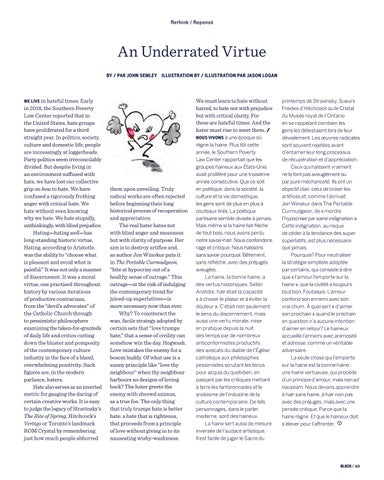Rethink / Repensé
An Underrated Virtue BY / PAR JOHN SEMLEY ILLUSTRATION BY / ILLUSTRATION PAR JASON LOGAN
WE LIVE in hateful times. Early in 2018, the Southern Poverty Law Center reported that in the United States, hate groups have proliferated for a third straight year. In politics, society, culture and domestic life, people are increasingly at loggerheads. Party politics seem irreconcilably divided. But despite living in an environment suffused with hate, we have lost our collective grip on how to hate. We have confused a rigorously frothing anger with critical hate. We hate without even knowing why we hate. We hate stupidly, unthinkingly, with blind prejudice. Hating—hating well—has long-standing historic virtue. Hating, according to Aristotle, was the ability to “choose what is pleasant and avoid what is painful.” It was not only a manner of discernment. It was a moral virtue, one practised throughout history by various iterations of productive contrarians, from the “devil’s advocates” of the Catholic Church through to pessimistic philosophers examining the taken-for-granteds of daily life and critics cutting down the bluster and pomposity of the contemporary culture industry in the face of a bland, overwhelming positivity. Such figures are, in the modern parlance, haters. Hate also serves as an inverted metric for gauging the daring of certain creative works. It is easy to judge the legacy of Stravinsky’s The Rite of Spring, Hitchcock’s Vertigo or Toronto’s landmark ROM Crystal by remembering just how much people abhorred
We must learn to hate without hatred, to hate not with prejudice but with critical clarity. For these are hateful times. And the hater must rise to meet them. / NOUS VIVONS à une époque où
them upon unveiling. Truly radical works are often rejected before beginning their long historical process of recuperation and appreciation. The real hater hates not with blind anger and meanness but with clarity of purpose. Her aim is to destroy artifice and, as author Jon Winokur puts it in The Portable Curmudgeon, “bite at hypocrisy out of a healthy sense of outrage.” This outrage—at the risk of indulging the contemporary trend for juiced-up superlatives—is more necessary now than ever. Why? To counteract the wan, facile strategy adopted by certain sets that “love trumps hate,” that a sense of civility can somehow win the day. Hogwash. Love mistakes the enemy for a bosom buddy. Of what use is a sunny principle like “love thy neighbour” when thy neighbour harbours no designs of loving back? The hater greets the enemy with shrewd animus, as a true foe. The only thing that truly trumps hate is better hate: a hate that is righteous, that proceeds from a principle of love without giving in to its nauseating wishy-washiness.
règne la haine. Plus tôt cette année, le Southern Poverty Law Center rapportait que les groupes haineux aux États-Unis avait proliféré pour une troisième année consécutive. Que ce soit en politique, dans la société, la culture et la vie domestique, les gens sont de plus en plus à couteaux tirés. La politique partisane semble divisée à jamais. Mais même si la haine fait flèche de tout bois, nous avons perdu notre savoir-haïr. Nous confondons rage et critique. Nous haïssons sans savoir pourquoi. Bêtement, sans réfléchir, avec des préjugés aveugles. La haine, la bonne haine, a des vertus historiques. Selon Aristote, haïr était la capacité « à choisir le plaisir et à éviter la douleur ». C’était non seulement le sens du discernement, mais aussi une vertu morale, mise en pratique depuis la nuit des temps par de nombreux anticonformistes productifs : des avocats du diable de l’Église catholique aux philosophes pessimistes scrutant les tenus pour acquis du quotidien, en passant par les critiques mettant à terre les fanfaronnades et le snobisme de l’industrie de la culture contemporaine. De tels personnages, dans le parler moderne, sont des haineux. La haine sert aussi de mesure inversée de l’audace artistique. Il est facile de juger le Sacre du
printemps de Stravinsky, Sueurs Froides d’Hitchcock ou le Cristal du Musée royal de l’Ontario en se rappelant combien les gens les détestaient lors de leur dévoilement. Les œuvres radicales sont souvent rejetées avant d’entamer leur long processus de récupération et d’appréciation. Ceux qui haïssent vraiment ne le font pas aveuglément ou par pure méchanceté. Ils ont un objectif clair, celui de briser les artifices et, comme l’écrivait Jon Winokur dans The Portable Curmudgeon, de « mordre l’hypocrisie par saine indignation ». Cette indignation, au risque de céder à la tendance des super superlatifs, est plus nécessaire que jamais. Pourquoi? Pour neutraliser la stratégie simpliste adoptée par certains, qui consiste à dire que « l’amour l'emporte sur la haine », que la civilité a toujours tout bon. Foutaises. L’amour confond son ennemi avec son vrai chum. À quoi sert « d’aimer son prochain » quand le prochain en question n’a aucune intention d’aimer en retour? Le haineux accueille l’ennemi avec animosité et adresse, comme un véritable adversaire. La seule chose qui l’emporte sur la haine est la bonne haine : une haine vertueuse, qui procède d’un principe d’amour, mais non ad nauseam. Nous devons apprendre à haïr sans haine, à haïr non pas avec des préjugés, mais avec une pensée critique. Parce que la haine règne. Et que le haineux doit s’élever pour l’affronter.
BLOCK / 49
